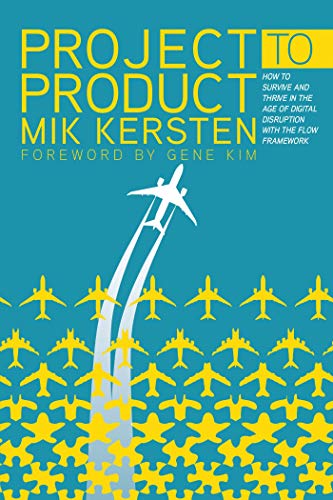Project to Product: How to Survive and Thrive in the Age of Digital Disruption with the Flow Framework Link to heading
Summary Link to heading
“Project to Product” by Mik Kersten is a guide for navigating the challenges of digital disruption by transitioning from traditional project-based thinking to a product-oriented approach using the Flow Framework. The book introduces the Flow Framework as a method that helps organizations shift their mindset to focus on product development and delivery. It outlines how organizations can use this framework to improve software delivery, reduce waste, and become more agile in response to market changes. The narrative includes a blend of industry insights, Kersten’s personal experiences, and case studies that support the proposed transformation strategy.
Review Link to heading
The book is well-regarded for its practical approach to the challenges faced by organizations in the digital age. Its key strength lies in providing a concrete framework (the Flow Framework) that organizations can use to realign their operations and focus on continuous value delivery. Mik Kersten leverages a wealth of real-world examples to support his arguments, making the concepts accessible and actionable. Some critics point out that the book can be overly technical for readers who are not deeply familiar with enterprise software development practices, but it remains a valuable resource for those seeking to understand or drive digital transformation.
Key Takeaways Link to heading
- Flow Framework: Introduces a framework that emphasizes value-based metrics over traditional project management metrics, aiming to optimize the flow of work and value creation in software delivery.
- Value Stream Management: Encourages organizations to manage software delivery as an integrated value stream instead of isolated projects, which can help align efforts across departments.
- Digital Transformation: Highlights the necessity for businesses to adapt to digital disruption by changing their management approaches and focusing on customer-centric product development.
- Visibility and Alignment: Stresses the importance of visibility into the work process to ensure alignment between business objectives and IT delivery.
- Continuous Improvement: Advocates for ongoing adjustment and improvement in processes and strategies based on feedback and changing customer needs.
Recommendation Link to heading
“Project to Product” is particularly suited for business leaders, IT professionals, and anyone involved in digital transformation initiatives. It provides valuable insights on aligning business strategies with modern software delivery practices and is especially beneficial for those interested in converting traditional management approaches to more agile, product-focused ones. The book can serve as a guide for those ready to embrace change and implement the Flow Framework to foster innovation and resilience in the face of digital disruption.
